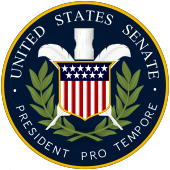President pro tempore of the United States Senate
|
President pro tempore of the US Senate |
|

|
|
| Official seal | |

|
|
|
Current incumbent Chuck Grassley since January 3, 2019 |
|
| Official seat | Capitol , Washington |
| Creation of office | March 4, 1789 |
| Deputy of | U.S. Vice President (in his role as Chairman of the Senate ) |
| Salutation |
Mr. President (Informal and Senate) The Honorable (Formal) |
The president pro tempore of the Senate of the United States ( english president pro tempore of the United States Senate ) is the second highest member of the Senate of the United States and the highest-ranking senator. The Vice President of the United States is ex officio Chairman of the Senate, making it its highest ranking member. In the absence of the Vice President, the President presides over the Senate pro tempore . The Latin term pro tempore literally means “temporarily”, in the broader sense “officiating”.
The Senate traditionally elects the senior senator of the largest parliamentary group as President pro tempore . In the general day-to-day business of the Senate, he usually does not chair it himself, but delegates this task to another Senator. The President pro tempore ranks third in succession to the President of the United States .
On January 3, 2019, Republican Chuck Grassley from Iowa succeeded his retired party friend Orrin Hatch from Utah , who had succeeded Democrat Patrick Leahy from Vermont in 2015 .
history
The office of president pro tempore was created in 1789 by the United States Constitution . Originally, this "acting deputy" was appointed by the Vice President for a few days or weeks if he was unable to attend the Senate meetings himself. Up until the 1960s it was common for the Vice President to chair the daily meetings of the House himself, so that the President rarely appeared in this capacity pro tempore .
Until 1891 the President only served in the Senate pro tempore until the Vice President himself took the chair again. If the Vice President failed again, a new President was appointed pro tempore . If the Vice President was permanently absent, the President served pro tempore until the end of the respective legislative period . It was only after 1891 that the office was filled over several legislative periods. From now on, most presidents remained in office pro tempore after their election until the majority changed or until they left the Senate.
From 1792 to 1886 the President was pro tempore the second substitute successor to the President and thus stood in the order behind the Vice President and in front of the Speaker of the House of Representatives .
Historically, the office was particularly important because the office of vice- president was only filled again at the next election until the 25th amendment to the constitution was passed in 1967 when an incumbent resigned or when he rose to the office of president. This was the president pro tempore in such a case to 1886 automatically second only to the president.
When Andrew Johnson , who had become president after Abraham Lincoln's death and had no vice-president, was charged with abuse of office in 1868, Benjamin Wade as incumbent president was pro tempore according to the law of the time next in line of candidates who should be eligible for the presidential failure Would advance to the presidency. Wade was one of Johnson's fiercest opponents and had also been a member of the commission that recommended the impeachment decision to be carried out. According to contemporaries and historians, the Senate’s decision not to remove Johnson from office was driven by Wade’s radical political views and his obvious interest in the outcome of the vote: the Senators did not want to see Wade in the White House .
In 1886 both the President pro tempore of the Senate and the Speaker of the House of Representatives were removed from the list of substitute successors for the President, but reinstalled in the reverse order in 1947. From 1947 to 1967, the president was pro tempore so after the Vice President and the Speaker of the House, the third replacement successor to the incumbent president.
There was an exceptional situation in the pro tempore election of the President between 1911 and 1913 due to the difficult majority situation: After the former incumbent William P. Frye resigned for health reasons, the progressive and conservative wing of the Republicans and the Republicans came to an agreement Democrats in the Senate on a temporary compromise solution for the replacement, according to which the candidates of the factions should take turns in the exercise of office.
See also
Web links
- President Pro Tempore - official Senate website
Individual evidence
- ↑ Hans L. Trefousse: Benjamin Franklin Wade: Radical Republican From Ohio. Twayne Publishers Inc., New York 1963, p. 309; see. John R. Lynch : The Facts of Reconstruction. New York 1913 (Internet source, accessed July 3, 2008, full quotation in Wikipedia article on Benjamin Wade ).